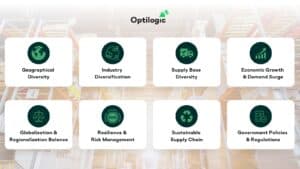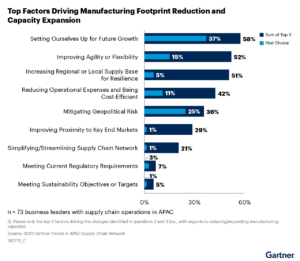
Discover how intelligent supply chain design enables executives to evaluate cost, service, risk, and sustainability trade-offs of changes to global supply chains. Explore case studies and strategies shaping the future of supply chains in Asia and around the world.
Published by
Minoru Muragi
Published on
October 17, 2024





Supply chain executives have been rattled with unpredictable events over the last several years including ongoing trade tensions with China. As a result, many companies are re-evaluating their supply chain network design and diversifying sourcing options to remain resilient despite uncertainty.
In this blog, we explore the key trends shaping supply chain design in Asia and how executives can assess the trade-offs of alternative sourcing and manufacturing strategies.
The notion of exiting China has become a prominent discussion among industry leaders. With rising labor costs, geopolitical tensions, and increasing tariffs, companies are re-evaluating their dependency on Chinese production. However, completely abandoning the Chinese manufacturing base can be daunting. Businesses are now asking, "How do we reduce dependence on China while maintaining production within Asia?" The answer lies in strategic diversification and gradual transition to other Asian countries that offer lower risks and costs. For some companies, exiting Asia completely and nearshoring operations may be a viable option.
To mitigate risks associated with a China-centric supply chain, many companies are exploring alternative Asian nations for sourcing and production.

Southeast Asian countries like Vietnam, Thailand, and Malaysia are emerging as viable options due to their growing skilled workforce and favorable economic environments. India's "Make in India" initiative also positions it as a competitive alternative with its diversified manufacturing base and large labor pool.
Before making any changes to the supply chain structure, it is crucial to assess the trade-offs between cost, service, and risk. This evaluation involves analyzing each potential location's infrastructure, political climate, regulatory environment, and logistical capabilities. The goal is to strike a balance that enhances resilience while optimizing operational costs. Organizations need to align, from executives to the operational departments – on what metrics define “good” - in terms of cost, service, risk, and sustainability metrics. The cross-departmental alignment is often overlooked when beginning the journey of changing sourcing strategies out of Asia and China in particular.
To stay ahead of disruptions, businesses must adopt proactive risk assessment strategies. This involves leveraging advanced technologies like AI and big data analytics to identify vulnerabilities. By creating a robust system for monitoring geopolitical developments, economic shifts, and environmental challenges, companies can better anticipate and mitigate potential supply chain disruptions. Building a digital model to measure and quantify potential risks before they occur is critical to disruption-prone supply chains. Supply chain simulation can test the impact on orders and customers impacted, while cost to serve analysis can show the margin impact on products and geographies. Alternative sourcing, production, and distribution policies that are not in planning systems today can be vetted to understand how best to plan for the top potential disruptions. And sensitivity analysis can reveal how incremental changes to cost, demand, lead-time, and capacity affect the robustness of your supply chain design. These resiliency playbooks could then be developed and at the ready when the real disruption occurs.

Asia is not a monolith; it comprises 48 countries, each with unique characteristics and business practices. Companies must understand these nuances to make informed supply chain design decisions. For instance, while China offers a skilled labor force and a robust supplier ecosystem, geopolitical uncertainties pose significant risks. Conversely, Southeast Asia's growth in manufacturing capabilities presents new opportunities for businesses looking to diversify.
A recent Gartner survey highlighted several critical focuses for business leaders in Asia when it comes to supply chain operations:

There is a marked trend of businesses reducing their capacity or exiting China. This shift is driven by the need to mitigate risks, reduce costs, and enhance resiliency. However, transitioning away from China requires careful planning and consideration of factors like production efficiency, local manufacturing opportunities, and regulatory impacts.
Formulating an effective exit strategy from China involves several considerations:
Countries like India, Thailand, and Malaysia are becoming increasingly attractive due to their growing workforce skills, political stability, and less regulatory burden compared to China. Enterprises must weigh these factors when evaluating nearshoring strategies to make the most suitable production and sourcing decisions.

Our first case study focuses on a prominent Japanese logistics company, highlighting how sustainability factors are influencing supply chain design in Asia, particularly in Japan. Alongside the growing emphasis on sustainable practices, labor shortages are also posing significant challenges for Japanese businesses. To optimize their supply chains, the company leveraged Optilogic’s Cosmic Frog supply chain design solution to identify efficient drone delivery routes for specific source-destination pairs. This innovative approach enabled them to assess costs, CO2 emissions, and service metrics effectively. Cosmic Frog facilitated a comparison between drone delivery and traditional trucking logistics, ultimately allowing the company to restructure their delivery systems and achieve a remarkable 25 percent reduction in costs as well as minimizing CO2 and labor.
A recent case study showcasing Cosmic Frog's advanced modeling capabilities involved a global automotive leader assessing the potential relocation of production from China to Europe, resulting in nearly 10 percent cost savings. This strategic move provided immediate financial benefits and opened the door for further savings through diversified supplier options, ultimately leading to an impressive 11.6 percent reduction in costs. Notably, supplier optimization was initially overlooked but became a key aspect of the supply chain strategy in Cosmic Frog’s recommendations. By leveraging Cosmic Frog's ability to balance cost, risk, service, and sustainability while analyzing multiple scenarios, the customer was empowered to explore many supply chain optimization opportunities. This approach revealed unexpected avenues for cost savings and strategic improvements, particularly by moving production away from China to Europe, which had not been considered during the initial design evaluation.
Supply Chain Design is crucial for companies worldwide, not just those operating in Asia. In Supply Chain Design decision-making, resiliency, risk, and sustainability are as important as cost, and these factors extend beyond the Asian market. Today, supply chains face constant disruptions from geopolitical risks and increasing concerns about sustainability and CO2 emissions. Supply chain design has changed, and organizations can no longer assume supply chains from a few years ago make sense today. Optilogic’s cloud native platform enables organizations to build a digital sandbox to test out new ideas to deal with today’s uncertain and volatile world. Create your free Cosmic Frog account today and start your journey with the most powerful supply chain design tool, ensuring you are ready for any challenges ahead.
Minoru Muragi is CEO of BigM, a consulting firm based in Tokyo, specializing in supply chain design, and an Optilogic partner. Our mission is to foster agility, enabling businesses to adapt to the constantly changing external environment and fluctuations, which serve as vital drivers of competitiveness. We offer consulting services to trading companies, logistics providers, manufacturers, and automotive companies, helping them navigate various supply chain challenges. Over time, we've observed that many organizations, including those based in the U.S., maintain supply bases in Asia. While each company has unique initiatives and concerns, most—if not all—can be effectively addressed through intelligent supply chain design.
Supply chain executives have been rattled with unpredictable events over the last several years including ongoing trade tensions with China. As a result, many companies are re-evaluating their supply chain network design and diversifying sourcing options to remain resilient despite uncertainty.
In this blog, we explore the key trends shaping supply chain design in Asia and how executives can assess the trade-offs of alternative sourcing and manufacturing strategies.
The notion of exiting China has become a prominent discussion among industry leaders. With rising labor costs, geopolitical tensions, and increasing tariffs, companies are re-evaluating their dependency on Chinese production. However, completely abandoning the Chinese manufacturing base can be daunting. Businesses are now asking, "How do we reduce dependence on China while maintaining production within Asia?" The answer lies in strategic diversification and gradual transition to other Asian countries that offer lower risks and costs. For some companies, exiting Asia completely and nearshoring operations may be a viable option.
To mitigate risks associated with a China-centric supply chain, many companies are exploring alternative Asian nations for sourcing and production.

Southeast Asian countries like Vietnam, Thailand, and Malaysia are emerging as viable options due to their growing skilled workforce and favorable economic environments. India's "Make in India" initiative also positions it as a competitive alternative with its diversified manufacturing base and large labor pool.
Before making any changes to the supply chain structure, it is crucial to assess the trade-offs between cost, service, and risk. This evaluation involves analyzing each potential location's infrastructure, political climate, regulatory environment, and logistical capabilities. The goal is to strike a balance that enhances resilience while optimizing operational costs. Organizations need to align, from executives to the operational departments – on what metrics define “good” - in terms of cost, service, risk, and sustainability metrics. The cross-departmental alignment is often overlooked when beginning the journey of changing sourcing strategies out of Asia and China in particular.
To stay ahead of disruptions, businesses must adopt proactive risk assessment strategies. This involves leveraging advanced technologies like AI and big data analytics to identify vulnerabilities. By creating a robust system for monitoring geopolitical developments, economic shifts, and environmental challenges, companies can better anticipate and mitigate potential supply chain disruptions. Building a digital model to measure and quantify potential risks before they occur is critical to disruption-prone supply chains. Supply chain simulation can test the impact on orders and customers impacted, while cost to serve analysis can show the margin impact on products and geographies. Alternative sourcing, production, and distribution policies that are not in planning systems today can be vetted to understand how best to plan for the top potential disruptions. And sensitivity analysis can reveal how incremental changes to cost, demand, lead-time, and capacity affect the robustness of your supply chain design. These resiliency playbooks could then be developed and at the ready when the real disruption occurs.

Asia is not a monolith; it comprises 48 countries, each with unique characteristics and business practices. Companies must understand these nuances to make informed supply chain design decisions. For instance, while China offers a skilled labor force and a robust supplier ecosystem, geopolitical uncertainties pose significant risks. Conversely, Southeast Asia's growth in manufacturing capabilities presents new opportunities for businesses looking to diversify.
A recent Gartner survey highlighted several critical focuses for business leaders in Asia when it comes to supply chain operations:

There is a marked trend of businesses reducing their capacity or exiting China. This shift is driven by the need to mitigate risks, reduce costs, and enhance resiliency. However, transitioning away from China requires careful planning and consideration of factors like production efficiency, local manufacturing opportunities, and regulatory impacts.
Formulating an effective exit strategy from China involves several considerations:
Countries like India, Thailand, and Malaysia are becoming increasingly attractive due to their growing workforce skills, political stability, and less regulatory burden compared to China. Enterprises must weigh these factors when evaluating nearshoring strategies to make the most suitable production and sourcing decisions.

Our first case study focuses on a prominent Japanese logistics company, highlighting how sustainability factors are influencing supply chain design in Asia, particularly in Japan. Alongside the growing emphasis on sustainable practices, labor shortages are also posing significant challenges for Japanese businesses. To optimize their supply chains, the company leveraged Optilogic’s Cosmic Frog supply chain design solution to identify efficient drone delivery routes for specific source-destination pairs. This innovative approach enabled them to assess costs, CO2 emissions, and service metrics effectively. Cosmic Frog facilitated a comparison between drone delivery and traditional trucking logistics, ultimately allowing the company to restructure their delivery systems and achieve a remarkable 25 percent reduction in costs as well as minimizing CO2 and labor.
A recent case study showcasing Cosmic Frog's advanced modeling capabilities involved a global automotive leader assessing the potential relocation of production from China to Europe, resulting in nearly 10 percent cost savings. This strategic move provided immediate financial benefits and opened the door for further savings through diversified supplier options, ultimately leading to an impressive 11.6 percent reduction in costs. Notably, supplier optimization was initially overlooked but became a key aspect of the supply chain strategy in Cosmic Frog’s recommendations. By leveraging Cosmic Frog's ability to balance cost, risk, service, and sustainability while analyzing multiple scenarios, the customer was empowered to explore many supply chain optimization opportunities. This approach revealed unexpected avenues for cost savings and strategic improvements, particularly by moving production away from China to Europe, which had not been considered during the initial design evaluation.
Supply Chain Design is crucial for companies worldwide, not just those operating in Asia. In Supply Chain Design decision-making, resiliency, risk, and sustainability are as important as cost, and these factors extend beyond the Asian market. Today, supply chains face constant disruptions from geopolitical risks and increasing concerns about sustainability and CO2 emissions. Supply chain design has changed, and organizations can no longer assume supply chains from a few years ago make sense today. Optilogic’s cloud native platform enables organizations to build a digital sandbox to test out new ideas to deal with today’s uncertain and volatile world. Create your free Cosmic Frog account today and start your journey with the most powerful supply chain design tool, ensuring you are ready for any challenges ahead.
Minoru Muragi is CEO of BigM, a consulting firm based in Tokyo, specializing in supply chain design, and an Optilogic partner. Our mission is to foster agility, enabling businesses to adapt to the constantly changing external environment and fluctuations, which serve as vital drivers of competitiveness. We offer consulting services to trading companies, logistics providers, manufacturers, and automotive companies, helping them navigate various supply chain challenges. Over time, we've observed that many organizations, including those based in the U.S., maintain supply bases in Asia. While each company has unique initiatives and concerns, most—if not all—can be effectively addressed through intelligent supply chain design.
Fill out the form to unlock the full content

